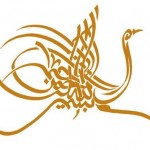
Arabic is a purely cursive script, written from right to left. The letters flow through angles and curves and can be shaped in a variety of ways and still be legible.
by Christine Huda Dodge
Calligraphy is a highly respected and important art form in Islamic culture because of its role in recording the Word of God in the Quran. The very first words revealed of the Quran itself encouraged people to read and indicated that God teaches human beings “by the pen.” As the Quran is so central to the faith of Islam, it was only natural that the highest art forms would develop around its preservation and beautification.
Arabic calligraphy developed as a way of beautifying the holy words of the Quran, but it later came to be used for more mundane and secular purposes as well.
While most early calligraphy was done in Arabic, the intricate script came to be applied to other languages that were part of the Islamic empire, including Farsi (Persian), Turkish, and Urdu.
This application of beautiful writing also extended to other arts, including inscriptions on pottery, textiles, and architectural monuments. These inscriptions may include verses of the Quran, traditions of Muhammad, or other words of God’s praise. Nearly all Islamic buildings have some inscription, often as a frame around doorways or ceilings, and a number of different writing styles may appear in different places. This gives variety and texture while attesting to the religious purposes of the building.
Calligraphy Styles
Arabic is a purely cursive script, written from right to left. The letters flow through angles and curves and can be shaped in a variety of ways and still be legible. Thus, Arabic script calligraphy can take on many styles, each developed to meet the demands of different occasions.
Each calligraphic style relies on geometric principles to make the words symmetrical and easy to read. The more rigid and angular scripts, such as the Kufi, were popular in the early Islamic world. The more cursive and rounded scripts, such as the Thuluth and Deewani, are considered more ornamental and beautiful. The most popular style for writing the Quran is known as the Naskh script, because the words are well spaced and easy to read. This style developed into an art form in sixteenth-century Turkey.
Illumination Techniques
As the various scripts developed, so too did additional techniques used to adorn the pages of the Quran and other important manuscripts. Gilded gold leaf and colored inks provided texture and visually enhanced the calligraphy of the Quran. Producing a fully illuminated, calligraphic manuscript was a time-consuming project. Such effort would usually be exerted to produce only the most holy religious texts.
Illumination of the Quran was done in moderation so that it did not distract the reader or detract from the meaning of the words. The most brilliant illumination was used sparingly, to mark the divisions between verses, highlight chapter headings, or frame a page or book cover.
Source: netplaces.com
Facebook Comments
Powered by Facebook Comments
 researching-islam | Before The End …Find The Truth Before The End ……. Find The Truth
researching-islam | Before The End …Find The Truth Before The End ……. Find The Truth